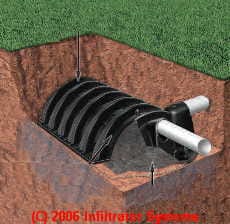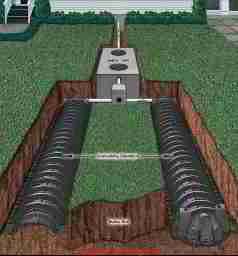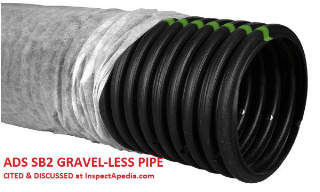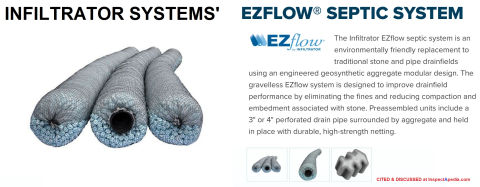 Gravelless Septic System Product Suppliers Directory
Gravelless Septic System Product Suppliers Directory
- POST a QUESTION or COMMENT about how & where to buy gravelless or "no-rock" septic system products & materials
Gravelless setic system sources:
Where to buy gravelless or no-rock septic system materials: this article discusses product suppliers for gravelless or "no gravel" or "no rock" septic drainfield systems.
InspectAPedia tolerates no conflicts of interest. We have no relationship with advertisers, products, or services discussed at this website.
- Daniel Friedman, Publisher/Editor/Author - See WHO ARE WE?
Sources of Gravelless Effluent Disposal Systems
Gravelless septic systems or "no gravel" septic system trenches use plastic or other prefabricated wastewater distribution systems which are buried in soil without the use of surrounding gravel. Typical gravelless septic systems use a plastic chamber, a geotextile-wrapped pipe, or a polystyrene-wrapped pipe to distribute effluent into the soil.
The necessary soil absorption area is provided by the perforated surface of the gravelless septic system components (or by soil at the bottom of a chamber) themselves rather than by the gravel and trench walls of a conventional septic drainfield.
These systems can provide an acceptable effluent disposal system for sites with limited space for a drainfield or where gravel is not available or is quite expensive.
[Click to enlarge any image]
This listing of suppliers of gravelless or "no rock" septic system components is arranged alphabetically.
The illustration at above left shows a typical residential gravelless wastewater disposal system using chambers.Illustration courtesy of Infiltrator Systems, Inc., used with permission. (Infiltrator Systems Inc. contact information is listed below).
- ADS Pipe, SB2 Pipe, multiple locations in the U.S. & Canada, Website: https://www.ads-pipe.com OPINON: Good luck trying to find a corporate headquarters address or contact information at this horrible webstite.
Excerpt: SB2 gravel-less leach bed pipe system can be a cost effective alternative to conventional leach beds.
The piping is comprised of eight or ten inch single wall corrugated polyethylene pipe with uniquely located perforations wrapped with ADS Drain Guard® and non-woven geotextile.
The outside diameters of the pipe provide an infiltrative soil absorption area. The location of the drain holes (60 degrees off the bottom center line) provide equal distribution along the entire trench.
The Drain Guard protective wrap is sonically welded to the corrugated pipe and allows free passage of effluent to the soil while limited soil particle infiltration.
- ADS ON SITE SEPTIC SYSTEMS PRODUCT DESCRIPTIONS [PDF] retrieved 2019/02/11 original source: http://www.pmstp.com/img/pdf/en/10265_On-Site_Septic.pdf
ADS - ARC 18-24 LEACHFIELD INSTALLATION GUIDE [PDF] for ADS ARC 24 leach field Chambers - CPP: Crumpler Plastic Pipe, Inc. provides fabric-wrapped drainage piping 800-334-5071 Roseboro NC USA - Website: http://www.cpp-pipe.com/no_rock.html "No-Rock TM Septic-Leachate drainpipe systems" are available in 8" and 10" systems.
- CPP’S No-Rock ™ Fabric Wrapped Septic Pipe [PDF] (2019) Crumpler Plastic Pipe, .O. Box 2068, Highway 24 West, Roseboro, NC 28382 USA, Tel: 1-800-334-5071
Email: cppsales@cpp-pipe.com retrieved 2019/02/11 original source: www.cpp-pipe.com/no_rock.html - Elgen, Website: http://www.eljen.com/Pages/In-Drain/Idmain.html, In-Drain from Elgen is a combination of plastic
and geotextile used to treat septic effluent.
Elgen products have been around for decades using variations on this design. Elsewhere I've recommended their drainage mat systems for foundation waterproofing and other site drainage problems.
Eljen In-drains: this no-rock septic system uses gravelless trenches containing prefabricated units of geotextile fabric and cuspated plastic spacing cores are bordered on the sides and beneath by six inches of specific sand media, and are covered with native soil.
A layer of protective fabric is placed on top of the units to prevent fine soil particles from clogging the filter fabric pores. - Hancor Gravelless "Blue Stripe" Pipe Website: http://www.hancor.com/product/Gravelless_Septic_Design.html Tel: 888-FOR-PIPE
8" and 10" diameter. Quoting the manufacturer, "When backfilled with native soil, Gravelless pipe provides safe and effective septic tank effluent treatment in sites determined to be suitable by your local health department.
The performance of gravelless systems has been verified through independent research performed at the University of Minnesota. This research evaluated the long-term acceptance rate of fabric-covered corrugated pipe for eight different soil types, and the pipe performed well in all soils tested except fine sand. Gravel-filled trenches in fine sand would likely perform in a similar manner.
Above: Infiltrator Systems' Arc 24 Chamber "no-rock" septic system product. [Click to enlarge any image]
- Infiltrator Systems, Inc.provides chamber products TEl: 800-718-2754 Old Saybrook CT USA.
Website: http://www.infiltratorsystems.com/
Infiltrator has \offices aroudn the world, including Algeria, Belgium, Canada, Chile, Columbia, France, Mexico, Morocco, New Zealand, Puerto Rico, Spain, and the United States.
Infiltrator Systems provides state specific design manuals for no-rock chamber systems for specific states in the U.S. - Infiltrator Systems ARC 24 CHAMBER SPECIFICATIONS [PDF] Op. Cit.,
Website excerpt:
Infiltrator’s recycled plastic septic chambers are engineered for strength and performance, easy to install, and have greater design flexibility (including a smaller footprint) as compared with stone and pipe.
The advantages of Infiltrator chambers add up to cost savings on labor, materials and time savings on the job.
- Infiltrator Systems also provides their EZFLOW filter-fabric-wrapped round bundles for effluent distribution, in a range of product sizes and capacities. [shown above]
Website excerpt:
The Infiltrator EZflow septic system is an environmentally friendly replacement to traditional stone and pipe drainfields using an engineered geosynthetic aggregate modular design.
The gravelless EZflow system is designed to improve drainfield performance by eliminating the fines and reducing compaction and embedment associated with stone.
Preassembled units include a 3" or 4" perforated drain pipe surrounded by aggregate and held in place with durable, high-strength netting.
- WA DOH, GRAVELLESS DISTRIBUTION PRODUCTS [PDF] (2014) Washington State Department of Health, Northeast Tri County Health District
240 E. Dominion Ave.
Colville, WA 99114USA, Tel: (509) 775-3111, retrieved 2019/02/11 original source https://www.netchd.org/fileadmin/user_upload/Environmental%20Health/Onsite%20Sewage/Guidelines_and_Standards/OSS-_Standards_and_Guidance_for_Gravelless_Distribution_Products-_September_2014.pdf
These documents include gravelless septic system design standards, operation and maitnenance guides, construction information.
GRAVELLESS EFFLUENT DISTRIBUTION PRODUCTS [PDF] (2013) Recommended Standards and Guidance for Performance, Application, Design, and Operation & Maintenance,
Washington State DOH, Wastewater Management Section, Post Office Box 47824 Olympia, Washington 98504-7824 USA, Tel: 360.236.3330 FAX: 360.236.2257 Email: wastewatermgmt@doh.wa.gov retrieved 2019/02/11 original source: https://www.doh.wa.gov/Portals/1/Documents/Pubs/337-005.pdf - Listing submissions welcome, there is no listing fee. InspectAPedia.com - Directory Listing & Link Exchange Instructions. Add your listing & support InspectAPedia.com by exchanging links - no listing fee & no conflicts of interest.
Gravelless or "no-rock" septic system designs are discussed in detail at GRAVELLESS SEPTIC SYSTEMS - design and installation specifications
InspectApedia.com has no financial or other relationship with any suppliers listed at our website and we do not endorse specific products. No fees or costs are involved in product source listings. CONTACT us to add information.
...
Consultants or supplies in this field can be listed at our alternative septic designers page at no charge by contacting us.
...
Reader Comments, Questions & Answers About The Article Above
Below you will find questions and answers previously posted on this page at its page bottom reader comment box.
Reader Q&A - also see RECOMMENDED ARTICLES & FAQs
On 2020-04-11 - by (mod) -
Rickey and Anonymous:
"Gravelless" or "no-rock" septic systems such as those described here do not use gravel in the leaching area.
On 2020-04-11 by Anonymous
Needing know what type grave used. The size.
On 2020-04-11 by Rickey
What type grave use on leach bed
On 2019-05-31 by Jeff
5 bedroom, perc @approx.7min. Per inch. Chamber system how many do I need. How many trenches??
On 2018-07-13 - by (mod) -
Apologies Paul but I'm unclear on what product you want to use for your septic absorption system. "Biodome" is a bit of a broad term that usually refers to a completely-enclosed, isolated environment that, within its interior, attempts to simulate a complete earth-like eco system. That would be an incredibly expensive approach to a home septic system and surely isn't what you're asking.
However IF you are asking about how to size a gravel-less or "no-rock" septic absorption system, you need first to check what is allowed in your country and city or state or province.
Watch out: when sizing any septic drainfield you should NOT rely on a generic drainfield size guess for any approach, whether gravelless or other systems. To install a system that will work and that can handle the anticipated daily wastewater flow rates you MUST consider both the average daily wastewater volume and the soil percolation rate - the rate at which your soils at your site in the absorption bed location will accept and dispose of effluent.
Watch out also: for both site restrictions (size, shape, property boundaries, distances to streams, lakes, buildings, etc., and for local code restrictions such as limits on the total length permitted for individual soakbed drain lines. So if the calculation such as in our example below shows that you need 600 feet of absorption trench, you will most likely not be permitted to run that as one single long line.
To give a general idea of what a graveless system manufacturer describes as typical site sizing we quote below from an established graveless system producer, CPP or Crumpler Plastic Pipe
ASTM-F-481 septic installation specification should be reviewed prior to installation. Some states allow Gravelless large diameter systems to be substituted for conventional systems in Any Soil Type deemed acceptable for a conventional system. Others do not. One should check with local septic inspectors for locally approved soils. Iron Ocre proned organic soils and fine silt soils are examples of unsuitable soil types for fabric wrapped pipes.
CPP’S No-Rock™ septic systems maybe substituted for any conventional 4” pipe gravel trench system utilizing distribution devices, serial distribution, hillside or stepdowns. However, it should not be substituted for bed systems or installed in fill material. It should also be limited to domestic sewage, and not used where there will be large amounts of grease or oil such as in restaurants unless designed by an engineer.
The 8” size pipe will equal to 2-foot wide conventional trench; and the 10” size will equal a 2.5-foot wide trench. To determine the required linear footage of either pipe size, first determine the square footage by dividing the design sewage flow by the appropriate soil’s long term application rate. Then divide this total square footage area figure by either 2 feet (for 8”) or 2.5 feet (for 10”) to establish the linear footage amount. Per chart below, on center (oc) spacing is determined by actual trench width.
Example:
A 3-bedroom house on a loam soil
0.6 gpd/ft 2 = loam soil’s long term application rate.
3BR x 120 gpd = =360 gpd
360 gpd ¸ 0.6 gpd/ft 2 = 600 ft.
600 ft 2 ¸ 2 ft = 300 linear ft of 8” or
600 ft 2 ¸ 2 ft = 240 linear ft of 10”
- retrieved 2018.07/13, original source: www.cpp-pipe.com/no_rock.html
On 2018-07-10 by paul
I have a 3 bedroom home with 2 bathrooms and I want to put biodome in how many feet of biodome do I need for this house
On 2018-01-29 by Robert Gollehon
What is the most cost effective drainfield type?
What are the different tyes?
Is there someone that I could email with questions?
Thank you,
Robert
odhelena1@gmail.com
On 2017-05-30 by Chinh
Where can graveless leachfield be bought in Seattle?
On 2016-12-18 by Sally miller
Where can graveless leachfield be purchased in Orlando Florida
On 2016-10-22 - by (mod) -
Excellent question David.
Check with the Arkansas Department of Health, since the state maintains a list of approved septic system component suppliers.
See http://www.healthy.arkansas.gov/programsServices/environmentalHealth/OnsiteWastewater/Documents/ApprovedList.pdf
On 2016-10-22 by David Stone
Where can gravelless leachfield lines be purchased in the Hot Springs Arkansas area?
...
Continue reading at GRAVELLESS SEPTIC SYSTEMS or select a topic from the closely-related articles below, or see the complete ARTICLE INDEX.
Or see these
Recommended Articles
- SEPTIC CONSULTANTS, DESIGNERS, ENGINEERS
- GRAVELLESS SEPTIC SYSTEMS
- SEPTIC EFFLUENT DISTRIBUTION Products Directory List
- SEPTIC FILTER / GRAYWATER FILTER SOURCES & Wastewater Treatment Systems Using Filtration Methods Products Directory
- SEPTIC SYSTEM DESIGN ALTERNATIVES
- SEPTIC SYSTEM DESIGN BASICS - home
- TYPES OF SEPTIC SYSTEMS - master list
Suggested citation for this web page
GRAVELLESS NO-ROCK SEPTIC SUPPLIERS at InspectApedia.com - online encyclopedia of building & environmental inspection, testing, diagnosis, repair, & problem prevention advice.
Or see this
INDEX to RELATED ARTICLES: ARTICLE INDEX to SEPTIC SYSTEMS
Or use the SEARCH BOX found below to Ask a Question or Search InspectApedia
Ask a Question or Search InspectApedia
Questions & answers or comments about how & where to buy gravelless or "no-rock" septic system products & materials.
Try the search box just below, or if you prefer, post a question or comment in the Comments box below and we will respond promptly.
Search the InspectApedia website
Note: appearance of your Comment below may be delayed: if your comment contains an image, photograph, web link, or text that looks to the software as if it might be a web link, your posting will appear after it has been approved by a moderator. Apologies for the delay.
Only one image can be added per comment but you can post as many comments, and therefore images, as you like.
You will not receive a notification when a response to your question has been posted.
Please bookmark this page to make it easy for you to check back for our response.
Comments
IF above you see "Comment Form is loading comments..." then COMMENT BOX - countable.ca / bawkbox.com IS NOT WORKING.
In any case you are welcome to send an email directly to us at InspectApedia.com at editor@inspectApedia.com
We'll reply to you directly. Please help us help you by noting, in your email, the URL of the InspectApedia page where you wanted to comment.
Citations & References
In addition to any citations in the article above, a full list is available on request.
- New York State Department of Health, APPENDIX 75-A WASTEWATER TREATMENT STANDARDS - INDIVIDUAL HOUSEHOLD SYSTEMS , [PDF] New York State Department of Health, 3 February 2010, retrieved 3/1/2010, original source: https://www.health.ny.gov/regulations/nycrr/title_10/part_75/appendix_75-a.htm
- Crumpler Plastic Pipe, Inc. Crumpler provides fabric-wrapped drainage piping 800-334-5071 Roseboro NC USA - "No-Rock TM Septic-Leachate drainpipe systems" are available in 8" and 10" systems.
- Jeff Pildis, Technical Service & Support, Infiltrator Systems, Inc. 800-718-2754
- Pennsylvania State Wastewater Treatment Fact Sheet SW-161, Septic System Failure: Diagnosis and Treatment
- Pennsylvania State Wastewater Treatment Fact Sheet SW-162, The Soil Media and the Percolation Test
- Pennsylvania State Wastewater Treatment Fact Sheet SW-l64, Mound Systems for Wastewater Treatment
- Pennsylvania State Wastewater Treatment Fact Sheet SW-165, Septic Tank-Soil Absorption Systems
- Document Sources used for this web page include but are not limited to: Agricultural Fact Sheet #SW-161 "Septic Tank Pumping," by Paul D. Robillard and Kelli S. Martin. Penn State College of Agriculture - Cooperative Extension, edited and annotated by Dan Friedman (Thanks: to Bob Mackey for proofreading the original source material.)
- Advanced Onsite Wastewater Systems Technologies, Anish R. Jantrania, Mark A. Gross. Anish Jantrania, Ph.D., P.E., M.B.A., is a Consulting Engineer, in Mechanicsville VA, 804-550-0389 (2006). Outstanding technical reference especially on alternative septic system design alternatives. Written for designers and engineers, this book is not at all easy going for homeowners but is a text I recommend for professionals--DF.
- Builder's Guide to Wells and Septic Systems, Woodson, R. Dodge: $ 24.95; MCGRAW HILL B; TP; Quoting from Amazon's description: For the homebuilder, one mistake in estimating or installing wells and septic systems can cost thousands of dollars. This comprehensive guide filled with case studies can prevent that. Master plumber R. Dodge Woodson packs this reader-friendly guide with guidance and information, including details on new techniques and materials that can economize and expedite jobs and advice on how to avoid mistakes in both estimating and construction. Chapters cover virtually every aspect of wells and septic systems, including on-site evaluations; site limitations; bidding; soil studies, septic designs, and code-related issues; drilled and dug wells, gravel and pipe, chamber-type, and gravity septic systems; pump stations; common problems with well installation; and remedies for poor septic situations. Woodson also discusses ways to
- In addition to citations & references found in this article, see the research citations given at the end of the related articles found at our suggested
CONTINUE READING or RECOMMENDED ARTICLES.
- Carson, Dunlop & Associates Ltd., 120 Carlton Street Suite 407, Toronto ON M5A 4K2. Tel: (416) 964-9415 1-800-268-7070 Email: info@carsondunlop.com. Alan Carson is a past president of ASHI, the American Society of Home Inspectors.
Thanks to Alan Carson and Bob Dunlop, for permission for InspectAPedia to use text excerpts from The HOME REFERENCE BOOK - the Encyclopedia of Homes and to use illustrations from The ILLUSTRATED HOME .
Carson Dunlop Associates provides extensive home inspection education and report writing material. In gratitude we provide links to tsome Carson Dunlop Associates products and services.





